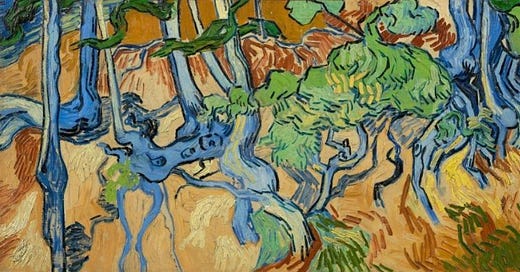Welcome to Thursday Things! This week is all about things that stand out from the rest. Let’s take a closer look!
Oh, the places you’ll van Gogh! Tree Roots, 1890, oil on canvas. Van Gogh Museum, Amsterdam
If you’re going to go to space, go to space in style. Virgin Galactic unveils sleek interior of SpaceShipTwo spaceliner.

Dibs on the window seat! Image: Virgin Galactic
The interior, which Virgin Galactic devised in collaboration with London-based design agency Seymourpowell, is sleek and stylish. The cabin's color palette "has been carefully curated so that it complements the architecture of the seat, the cabin itself and spacesuits," company representatives wrote in the same statement. "The golden metallics resemble luminous desert sands, blues conjure celestial spaces and teals inspired by the ocean ground travelers back to Earth."
Yes, I was saying just the other way, gold and teal is the way to go for spaceship interiors. It really accentuates the star field.
Violent stalker finds Japanese artist’s home by zooming in on her eye. And this is precisely why I post so few pictures of myself online.
Phone cameras are getting scarily sharp. So much so that a disturbed stalker was able to track down the address of a popular Japanese artist from selfies she posted on social media — by literally zooming in on the reflection of her eyes.
The obsessed fan, Hibiki Sato, later used the information he gathered to attack 21-year-old member of J-pop collective Tenshitsukinukeniyomi, Ena Matsuoka, in front of her home in Tokyo, according to local outlets. The assault took place on September 1.
The 26-year-old assailant picked up the location by identifying a bus stop in the reflection in her eyes and matching it to a street using Google Maps, AsiaOne reports.
Also why I never post vacation photos until I get back from the vacation. If ever.
Same concept as the last item, but for more benign purposes: A Clue to Van Gogh’s Final Days Is Found in His Last Painting. Some clever chap studied Van Gogh’s last painting for clues about his whereabouts on his last day of life:
“We now know what he was doing during his last day” before he was shot, said Mr. van der Veen, the scientific director of the Van Gogh Institute, a nonprofit established to preserve the artist’s tiny room at the Auberge Ravoux, the inn in Auvers-sur-Oise. “We know that he spent all day painting this painting,” Mr. van der Veen noted.
“Tree Roots” was painted on the Rue Daubigny, a main road through Auvers-sur-Oise, which is about 20 miles north of Paris, Mr. van der Veen found. The tangled, gnarled tree roots and stumps can still be seen in the slope of a hill there today, just 500 feet from the Auberge Ravoux, where van Gogh spent the last 70 days of his life.
The clever history detective had a real aha! moment:
Mr. van der Veen said that he was pointed toward the discovery while looking at images of Auvers from about 1905, which he had borrowed from Janine Demuriez, a 94-year-old Frenchwoman who has collected hundreds of historical postcards. One shows a cyclist on the Rue Daubigny, stopping next to a steep embankment, where tree roots are clearly visible.
Read the whole thing. This story could be, and probably will be, a movie. Or at least a History special. Here is another take on the story, with lots of pictures of the tree roots in question: Van Gogh detective discovers exact spot of artist's last work, painted just hours before his suicide
Sometimes it is better to be blue. Red Lobster worker saves rare blue lobster, donates to zoo.
While going through a delivery shipment at the Cuyahoga Falls, Ohio, Red Lobster restaurant, an employee spotted a standout specimen: There was a rare blue lobster in the batch.
The employee quickly decided that the special shelled seafarer deserved better than being served as seafood, then named him Clawde and sought to find the lobster a forever home.
Through conservation partnership Seafood Watch, which is run by California’s Monterey Bay Aquarium, Clawde was quickly adopted by the Akron Zoo, not far from the Red Lobster branch.
I bet all of the other lobsters used to laugh and call him names. Who’s laughing now, suckers?
If you have to be a lobster, be a blue lobster.
The Wizard of Oz, DNA edition. How Scientists Encoded “The Wizard of Oz” Into DNA: University of Texas researchers unveil protocol to shuffle large data stores into strands of genetic material.
Synthetic DNA as a high-density data storage medium has fascinated digital futurists for years. The entire internet could be coded into DNA strands that fit inside a shoebox, while the DNA molecule is so stable it can last tens of thousands or even hundreds of thousands of years. In 2013, for instance, scientists sequenced the entire genome of a 700,000 year-old horse fossil.
The trick to date has involved shoehorning vast sums of bytes—a data standard tailor-made for linear and sequential stores like RAM and hard drives—into wet, squiggly forests of nano-sized deoxyribonucleic spaghetti noodles. Translating one data format to the other has been anything but straightforward.
Yes, I imagine that is difficult. But we’re here to see the Wizard!
The group used L. Frank Baum’s The Wizard of Oz, translated into Esperanto no less, as their sample data set to be stored. Synthetic DNA these days, Jones said, typically comes in strands of one-hundred or so base pairs. That’s the foundation of their “hard drive,” as it were.
Bottom line, University of Texas researchers encoded the text of The Wizard of Oz into DNA to test it as a data storage medium. This story would be so much better if the researchers were from the University of Kansas. Missed opportunity there.
I wish next time they would use one of my books. I know Baum’s classic is in public domain, but I would be happy to grant permission to encode Hero Wanted into DNA for Science! to advance. And I could use the publicity!
Thank you for reading Thursday Things! See you next Thursday!



